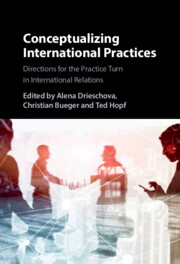Book contents
- Conceptualizing International Practices
- Conceptualizing International Practices
- Copyright page
- Contents
- Figures
- Table
- Contributors
- Acknowledgements
- Part I Introduction: Conversations and the Evolution of Practice Theorizing
- Part II Key Concepts of IR Scholarship
- 3 Epistemic Communities of Practice
- 4 Practices and Norms
- 5 The Normativity of International Practices
- 6 Resistance as Practice
- 7 For a Practice Approach to Authority
- 8 Evolution in International Practices
- Part III Innovative Concepts
- Part IV Conclusion: The Future of Practice Theorizing
- References
- Index
8 - Evolution in International Practices
from Part II - Key Concepts of IR Scholarship
Published online by Cambridge University Press: 09 June 2022
- Conceptualizing International Practices
- Conceptualizing International Practices
- Copyright page
- Contents
- Figures
- Table
- Contributors
- Acknowledgements
- Part I Introduction: Conversations and the Evolution of Practice Theorizing
- Part II Key Concepts of IR Scholarship
- 3 Epistemic Communities of Practice
- 4 Practices and Norms
- 5 The Normativity of International Practices
- 6 Resistance as Practice
- 7 For a Practice Approach to Authority
- 8 Evolution in International Practices
- Part III Innovative Concepts
- Part IV Conclusion: The Future of Practice Theorizing
- References
- Index
Summary
The chapter starts from a seeming contradiction in practice theory: on the one hand, change is an ever-present condition at the micro-level; on the other, homeostatic tendencies prevail at the macro-level. Indeed, taking a historical perspective suggests that practices do change, though mostly around the edges, at a slow pace, and often without a clear direction. Drawing on the evolutionary metaphor, the chapter departs from intentional and reflexive accounts of change, to instead focus on the social environment within which practice variations occur. The web of practices helps explain the differential rate of reproduction and success of particular ways of doing things, including subversive, deviant, innovative, and incompetent performances. In order to survive its context of emergence and gain a foothold in the world, a variant practice needs back-up from surrounding modes of action, whether it be through public display, relational crossover, or inscription. By implication, the evolution of (international) practices describes a socially emergent, macro-process in which the social environment provides the structural impetus for some variations to stick around while most drop out.
- Type
- Chapter
- Information
- Conceptualizing International PracticesDirections for the Practice Turn in International Relations, pp. 170 - 190Publisher: Cambridge University PressPrint publication year: 2022
- 1
- Cited by



